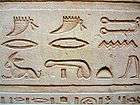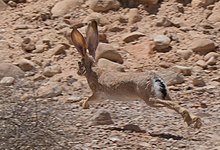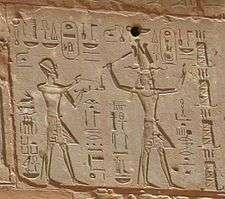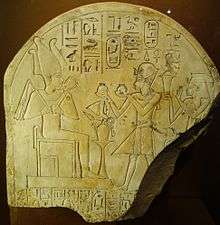Hare (hieroglyph)
The ancient Egyptian Hare hieroglyph, Gardiner sign listed no. E34 (𓃹) is a portrayal of the desert hare (Cape hare, Lepus capensis) of Egypt, within the Gardiner signs for mammals. The ancients used the name of sekhat for the hare.[1]
It is an Egyptian language biliteral with the value wn,[2] (or un), often used in a hieroglyph composition block with the horizontal n.
, or
| Hare in hieroglyphs |
|---|

Hare hieroglyph in text (reading left-to-right).

Lepus capensis sinaiticus
The biliteral expresses the sound "oon", or "oonen",;[3] it is also an ideogram for the verb "to be", or "to exist",[4] (i.e. "is", "are", "was", etc.).
The famous Pharaoh Unas, (for his Pyramid texts), is named using the hare hieroglyph. It also appears in the name of Wenamun, a (possibly fictional) priest who appears in a famous history of c. 1000 BCE.
}
| Preceded by sun-with-rays - "uben"-phon.-etc. (complex, many word uses) |
hare -- un |
Succeeded by unem (right = "west") Emblem of the West (hieroglyph) | ||||||
| Succeeded by swallow-(bil.)--animal leg-(tril.) ---- ur ---- ---- uhm ---- |

- Detail of Hare and water-ripple quadrat (hieroglyph block)
(also shows Stool-or-mat (hieroglyph) and Throne (hieroglyph)) - Vertical text, hare hieroglyph at beginning
 Partially missing lunette of a stela; Finely executed in shallow, incised-bas relief
Partially missing lunette of a stela; Finely executed in shallow, incised-bas relief
See also
| Wikimedia Commons has media related to Hare (wn hieroglyph). |
- Gardiner's Sign List#E. Mammals
- List of Egyptian hieroglyphs
- Pharaoh Unas - (titulary)
References
- Schumann-Antelme, and Rossini, 1998. Illustrated Hieroglyphics Handbook, biliteral: B80, p. 232-233.
- Schumann-Antelme, and Rossini, 1998. Biliteral: B80, p. 232-233.
- Schumann-Antelme, and Rossini, 1998, p. 232-233, p. 232.
- Schumann-Antelme, and Rossini, 1998, p. 232-233, p. 232.
- Schumann-Antelme, and Rossini, 1998. Illustrated Hieroglyphics Handbook, Ruth Schumann-Antelme, and Stéphane Rossini. c 1998, English trans. 2002, Sterling Publishing Co. (Index, Summary lists (tables), selected uniliterals, biliterals, and triliterals.) (softcover, ISBN 1-4027-0025-3)
This article is issued from Wikipedia. The text is licensed under Creative Commons - Attribution - Sharealike. Additional terms may apply for the media files.